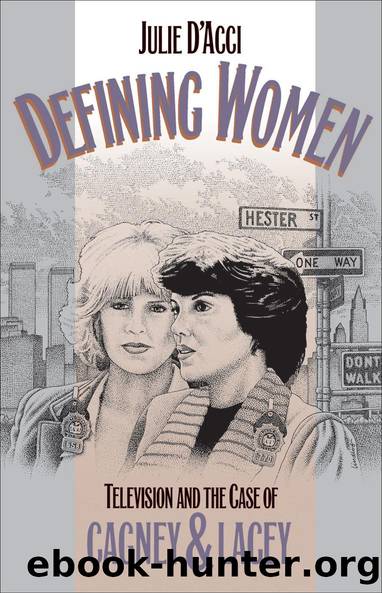Defining Women by Julie D'Acci

Author:Julie D'Acci [D'Acci, Julie]
Language: eng
Format: epub
Tags: Social Science, Media Studies
ISBN: 9780807860960
Google: i-BvCQAAQBAJ
Publisher: Univ of North Carolina Press
Published: 2000-11-09T03:53:16+00:00
CONSIDERING THE VARIOUS REPRESENTATIONS OF FEMINISM
The explicit feminism of the Cagney and Lacey made-for-TV movie and the Foster/Daly series made absolutely clear that the positions of the characters and of the narratives as a whole emerged from a social and cultural movement of women who set out to have political influence over their own material conditions. This type of feminism also pointed to the institutionalized, structural inequities of gender, race, and to some degree class. Furthermore, many of its dimensionsâCagney and Laceyâs struggles with discrimination on the job and with the men in the precinct and their own declared and hard-hitting viewpoints as feministsâwere unique and much too short-lived on prime-time TV. But there were, as we saw, dangers and problems in negotiating this explicit feminism on mainstream commercial television.
In addition to the problems discussed above, there were also difficulties related more specifically to the constraints of 1980s network prime time drama itself. As we know, television at that time rarely depicted explicit feminism in its series and consequently did not offer an array of competing and conflicting feminist positions. Such a situation fostered the assumption that the âfeminismâ or the feminist position being portrayed was all inclusiveâthat is, that it delineated the universe of womenâs movement views. Prime time in the 1980s, furthermore, demanded a feminist perspective that could be rendered in broad and accessible strokes and was part of everyday popular discourse. Liberal feminism appeared to be the logical and perhaps only candidate for such depictions, and so, from the outset, feminismâs dimensions and differences were severely restricted.
That explicit feminism (even though delimited and at times offensive) actually came to the TV screen in a dramatic series format was, however, a remarkable occurrence. And without the legacy of its initial attempts, Cagney and Lacey would most likely not have exhibited the possibilities for continued feminist readings. This legacy was simply the commitment to pursuing some form of womenâs movement inquiry, the continuation of overt feminism in the womenâs-issues episodes, and the tacit or ambiguous feminism that camouflaged itself at the level of characterization.
Cagney and Laceyâs original handling of feminism was too controversial for mainstream, prime-time TV, and through institutional and textual negotiations it became less socially general and less explicit. The shift to womenâs-issues feminism had both problematic and positive aspects, neither of which can be ignored. As we have seen, the womenâs-issues shows tended to ratify the notions that feminism and social atrocities like rape, wife abuse, incest, and sexual harassment were female concerns and could be restricted to historically constructed women. They also exploited such issues for their sensational dimensions and produced women as victims. From another point of view, however, they gave the issues widespread exposure and reassured women in the audience that they were not alone in their experiences. The turn to both womenâs-issue feminism and feminism disguised at the level of characterization doubtless allowed a program that portrayed womenâs movement material to remain on a popular mass medium during the throes of a
Download
This site does not store any files on its server. We only index and link to content provided by other sites. Please contact the content providers to delete copyright contents if any and email us, we'll remove relevant links or contents immediately.
| Direction & Production | Genres |
| Guides & Reviews | History & Criticism |
| Reference | Screenwriting |
| Shows |
Head of Drama by Sydney Newman(2028)
Robin by Dave Itzkoff(2017)
I'm Judging You by Luvvie Ajayi(1896)
The Paranormal 13 (13 free books featuring witches, vampires, werewolves, mermaids, psychics, Loki, time travel and more!) by unknow(1852)
Single State of Mind by Andi Dorfman(1518)
Ten by Gretchen McNeil(1507)
#MurderTrending by Gretchen McNeil(1402)
Key to the Sacred Pattern: The Untold Story of Rennes-le-Chateau by Henry Lincoln(1356)
Most Talkative by Andy Cohen(1314)
Merv by Merv Griffin(1271)
This Is Just My Face by Gabourey Sidibe(1186)
Notes from the Upside Down by Guy Adams(1183)
Jamie Oliver by Stafford Hildred(1151)
The Hunger Games: Official Illustrated Movie Companion by Egan Kate(1125)
Springfield Confidential by Mike Reiss(1112)
Clarkson--Look Who's Back by Gwen Russell(1082)
The TV Writer's Workbook: A Creative Approach To Television Scripts by Ellen Sandler(1076)
Blue Planet II by James Honeyborne & Mark Brownlow(1026)
Dark Angel by D. A. Stern(1018)
